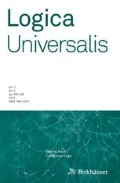Abstract
In this article I will show why and how it is useful to exploit the hexagon of opposition to have a better and new understanding of the relationships between morality and violence and of fundamental axiological concepts. I will take advantage of the analysis provided in my book Understanding Violence. The Intertwining of Morality, Religion, and Violence: A Philosophical Stance. Springer, Heidelberg/Berlin, 2011) to stress some aspects of the relationship between morality and violence, also reworking some ideas by John Woods concerning the so-called epistemic bubbles, to reach and describe my own concept of moral bubbles. The study aims at providing a simple theory of basic concepts of moral philosophy, which extracts and clarifies the strict relationship between morality and violence and more, for example the new philosophical concept of overmorality. I will also conclude that this kind of hybrid diagrammatic reasoning is a remarkable example of manipulative explanatory abduction—through drawing—in the spirit of “conceptual structuralism”, promoted by Robert Blanché and further developed by Jean-Yves Béziau.
Similar content being viewed by others
References
Bardone E., Magnani L.: The appeal of gossiping fallacies and its eco-logical roots. Pragmatics Cognition 18(2), 365–396 (2010)
Baumeister, R.: Evil. Inside Human Violence and Cruelty. Freeman/Holt Paperbacks, New York (1997)
Bertolotti T., Magnani L.: A philosophical and evolutionary approach to cyber-bullying: social networks and the disruption of sub-moralities. Ethics Inf. Technol. 15(4), 285–299 (2013)
Béziau J.-Y.: The power of the hexagon. Log. Univers. 6, 1–43 (2012)
Bingham P.M.: Human uniqueness: a general theory. Q. Rev. Biol. 74(2), 133–169 (1999)
Bingham P.M.: Human evolution and human history: a complete theory. Evol. Anthropol. 9(6), 248–257 (2000)
Boehm, C.: Hierarchy in the Forest. Harvard University Press, Cambridge (1999)
Coeckelbergh M.: Criminal or patients? Towards a tragic conception of moral and legal responsibility. Crim. Law Philos. 4, 233–244 (2010)
de Vries, H.: Religion and Violence. Philosophical Perspectives from Kant to Derrida. Johns Hopkins University Press, Baltimore and London (2002)
Husak D.: Overcriminalization. The Limits of the Criminal Law. Oxford University Press, Oxford (2008)
Kant, I.: Religion within the Boundaries of Mere Reason [1793]. Cambridge University Press, Cambridge, (1998). Translated and edited by A. Wood and G. di Giovanni. Introduction by R. M. Adams.
Magnani L.: Morality in a Technological World. Knowledge as Duty. Cambridge University Press, Cambridge (2007)
Magnani, L.: Abductive Cognition. The Epistemological and Eco-Cognitive Dimensions of Hypothetical Reasoning. Springer, Heidelberg/Berlin (2009)
Magnani, L.: Understanding Violence. The Intertwining of Morality, Religion, and Violence: A Philosophical Stance. Springer, Heidelberg/Berlin (2011)
Odling-Smee F.J., Laland K.N., Feldman M.W.: Niche Construction. The Neglected Process in Evolution. Princeton University Press, Princeton (2003)
Pinker S.: The cognitive niche: coevolution of intelligence, sociality, and language. PNAS (Proc. Natl. Acad. Sci. USA) 107, 8993–8999 (2010)
Rachels, J.: The Elements of Moral Philosophy. McGraw Hill College, Boston Burr Ridge (1999)
Reesor M.E.: The “indifferents” in the old and middle Stoa. Trans. Proc. Am. Phil. Assoc. 82, 102–110 (1951)
Smith Holt, S., Loucks, N., Adler, J.R.: Religion, culture, and killing. In: Rothbart, D., Korostelina, K.V. (eds). Why We Kill. Understanding Violence across Cultures and Disciplines, pp 1–6. Middlesex University Press, London (2009)
Wilson D.S., Timmel J.J., Miller R.R.: Cognitive cooperation. When the going gets tough, think as a group. Hum. Nat. 15(3), 1–15 (2004)
Woods, J.: Errors of Reasoning. Naturalizing the Logic of Inference. College Publications, London (2013)
Žižek, S.: The Puppet and the Dwarf. The Perverse Core of Christianity. The MIT Press, Cambridge (2003)
Žižek, S.: Violence [2008]. Profile Books, London (2009)
Author information
Authors and Affiliations
Corresponding author
Rights and permissions
About this article
Cite this article
Magnani, L. Violence Hexagon. Log. Univers. 10, 359–371 (2016). https://doi.org/10.1007/s11787-016-0140-5
Received:
Accepted:
Published:
Issue Date:
DOI: https://doi.org/10.1007/s11787-016-0140-5



